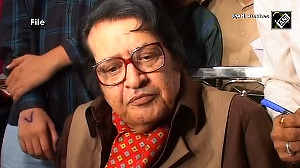Wipro's Consumer Care & Lighting business offers a range of toiletries, wellness products, baby care products, lighting solutions and office furniture. It accounts for close to 9 per cent of the group top line of around Rs 25,000 crore, majorly derived from software exports and IT products.
The share has been gradually increasing. Four years earlier, it was just 5.7 per cent. The share is expected to go up in the coming years, as Wipro is aggressively looking to bring in a premium range of products from Singapore-based Unza, a personal care firm which it acquired during 2007 for around Rs 900 crore.
Nearly half the Rs 2,500 crore top line comes from its two main soap brands, Santoor and Chandrika. Another Rs 800 crore comes from Unza, from Malaysia, Singapore, Vietnam, Indonesia, China and the West Asian markets. The rest is accounted for by a few of Wipro's wellness and baby care products, the lighting and furniture business. The lighting business is starting to make an impact, driven by a 'Green Buildings' strategy.
After Santoor became the number one soap brand in South India, the next step would be to aim at the rest of India (the brand's national market share is just 8 per cent). The Rs 8,000-crore Indian toilet soap market is dominated by Hindustan Unilever; two of its brands, Lifebuoy and Lux, hold the top two positions. Wipro is working through pricing-led strategy to come closer to them. "We have a long way to go," says Vineet Agrawal, president of Wipro Consumer Care and Lighting.
Company officials said the consumer care business was growing faster than the overall industry level and hoped to achieve a bigger share in future, with a range of initiatives such as repackaging the product, making it available at appealing price points and bringing in product extensions, while trying to keep its costs under a tight leash.
"The industry is growing at the rate of 16-17 per cent, while we are growing at almost 30 per cent. Our aim is to maintain this growth and gain a bigger share in future," he said.
Agrawal said for the Santoor brand, the thrust had been on rural India, where the global financial crisis didn't have much of an impact. Santoor has been growing at 29 per cent for the past three years, on a year-on-year basis. In the first quarter of FY10, 55 per cent of Santoor's volume growth came from rural India, that grew 9.1 per cent in the first quarter as compared to 6.3 per cent in urban India.
It is this terrain that Wipro Consumer Care is focusing on, by expanding its distribution into the hinterland. Wipro's enhanced focus on rural markets is also enabled by its move to price its offerings pretty competitively as against the market leaders.
Much of this has been attributed to the success of the company's strategy not in just in terms of market focus, but also in terms of sourcing of ingredients. The better operating margin in the last quarter came as the company sourced palm oil, a prime ingredient used in the soaps at a time when the price was at its lower band.
"Fundamentally, the main ingredient in soaps is palm oil, which we largely import from Indonesia and Malaysia. Due to fluctuations in the rate of palm oil you have to ensure that you buy at the right time. Currently prices are not at an all-time low but they are still low," said Agrawal.
The company also, perhaps for the first time in many years, saw the operating margin from the consumer care and lighting business go up to as high as 14.4 per cent, against the usual range of 11-13 per cent.
The success of Santoor as a brand, according to analysts, has been its inherent value. "Santoor is a distinctive product at the end of the day and I do believe that they had been able to deliver a great value to the market," says brand consultant Harish Bijoor.
Keeping in mind the affordability of the rural consumers, the company has already launched Santoor in value packs of Rs 6 and Rs 10 each and also variants such as talcum powder and face wash at similar price points.
Agrawal added one of the successes of the company in the consumer care business had been consistent spending in advertising. "Generally, FMCG companies keep the advertising budget at 7-12 per cent of their sales. We have been consistently keeping about 11 per cent of our sales as advertising spend," he says.
In the FMCG space, the company has already made its foray into the wellness segment, with the test-launching of honey under the brand name of Wipro Sanjeevani in AP and Maharashtra. Wipro Sweet & Healthy, a low calorie sweetener test-launched in Andhra, has evoked good response.
While Wipro is looking aggressively at the bottom of the pyramid to push its volumes, it is also considering the idea of bringing in premium products from Unza. The emergence of modern retail in India is a route that the company is looking to tap for these products.
Growth in the lighting and furniture business, which contributes close to 18 per cent of WCCL's revenue, has been flat for the past couple of quarters. The company has adopted a different strategy in this segment, with the launch of a new furniture range from international designers to address the upper end of the market.







 © 2025
© 2025